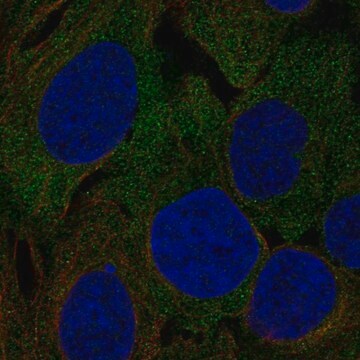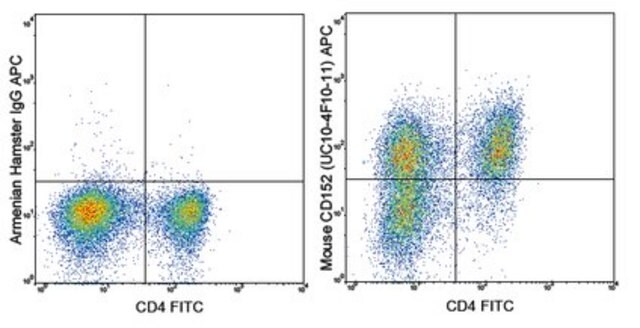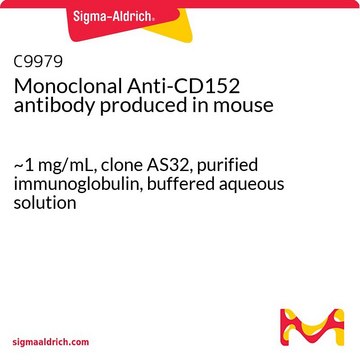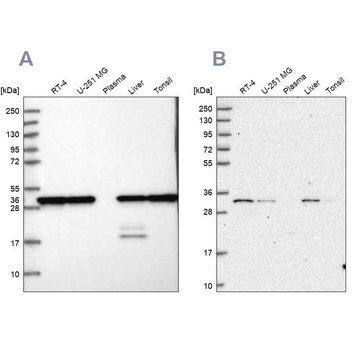04-963
Anti-CTLA4 (CD152) Antibody, clone 9H10
clone 9H10, from hamster
Synonym(e):
CD152 antigen, Cytotoxic T-lymphocyte-associated antigen 4, celiac disease 3, cytotoxic T-lymphocyte-associated protein 4, cytotoxic T-lymphocyte-associated serine esterase-4, ligand and transmembrane spliced cytotoxic T lymphocyte associated antigen 4
About This Item
Empfohlene Produkte
Biologische Quelle
hamster
Qualitätsniveau
Antikörperform
purified immunoglobulin
Antikörper-Produkttyp
primary antibodies
Klon
9H10, monoclonal
Speziesreaktivität
mouse
Methode(n)
flow cytometry: suitable
immunoprecipitation (IP): suitable
western blot: suitable
Isotyp
IgG
NCBI-Hinterlegungsnummer
UniProt-Hinterlegungsnummer
Versandbedingung
wet ice
Posttranslationale Modifikation Target
unmodified
Angaben zum Gen
human ... CD28(940) , ICOS(29851)
Allgemeine Beschreibung
Spezifität
Immunogen
Anwendung
Entzündung & Immunologie
Transkriptionsfaktoren
Entzündungs- & Autoimmunmechanismen
FACS analysis of ConA (24 hours) stimulated BALB/C splenocytes for surface expression of CTLA-4 (CD152). Cells were stained with 10 ug of biotin-labeled hamster anti-CTLA-4 ,clone 9H10 (open histogram) or with PE-Sav secondary antibody alone (histogram, Figure B). Note the distinct signal difference between the control (dark control histogram) and test (clear histogram).
Immunoprecipitation: Clone 9H10 is widely used for immunoprecipitaiton of CTLA-4; recommended lysis buffers include 1% NP40; 0.5% triton X-100 with proteinase inhibitors; 1-5 µg of 9H10 is added to 300-500 µL of whole cell lysate or cell membrane protein preparations (250-500 mg/mL totall protein) and incubated 3-6 hours at 4°C, followed by capture with protein G beads following standard immunoprecipitation methods (Zhang, Y., et al., 1997).
Qualität
Western Blot Analysis: 1 µg/mL of a biotinylated version of this antibody detected CTLA4 in 10 µg of mouse spleen lysate.
THIS ANTIBODY IS NO BIOTINYLATED.
Zielbeschreibung
Physikalische Form
Lagerung und Haltbarkeit
Hinweis zur Analyse
Mouse spleen cell lysate
Sonstige Hinweise
Haftungsausschluss
Sie haben nicht das passende Produkt gefunden?
Probieren Sie unser Produkt-Auswahlhilfe. aus.
Lagerklassenschlüssel
12 - Non Combustible Liquids
WGK
WGK 1
Flammpunkt (°F)
Not applicable
Flammpunkt (°C)
Not applicable
Analysenzertifikate (COA)
Suchen Sie nach Analysenzertifikate (COA), indem Sie die Lot-/Chargennummer des Produkts eingeben. Lot- und Chargennummern sind auf dem Produktetikett hinter den Wörtern ‘Lot’ oder ‘Batch’ (Lot oder Charge) zu finden.
Besitzen Sie dieses Produkt bereits?
In der Dokumentenbibliothek finden Sie die Dokumentation zu den Produkten, die Sie kürzlich erworben haben.
Unser Team von Wissenschaftlern verfügt über Erfahrung in allen Forschungsbereichen einschließlich Life Science, Materialwissenschaften, chemischer Synthese, Chromatographie, Analytik und vielen mehr..
Setzen Sie sich mit dem technischen Dienst in Verbindung.







